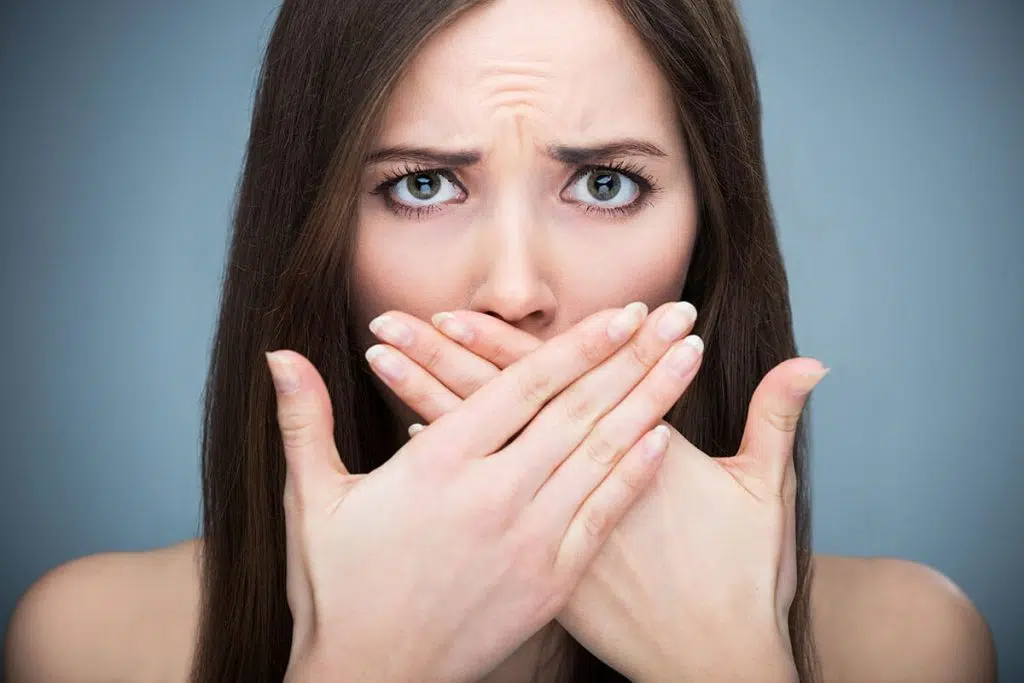What Causes Bad Breath and How Can It Be Treated?

Bad breath, also commonly known as “halitosis” is an odor that is associated with the mouth that 50% of Americans suffer from and increase in intensity as a person ages. There are many causes of bad breath and the treatment for it depends upon the reason for the bad breath. This article will briefly describe the causes of bad breath, how it can be discovered, and how it can be treated.
What are the Causes of Bad Breath?
Morning breath (physiologic halitosis) is caused by a slow down of saliva in the mouth while a person sleeps. Because the food particles are not moved around the mouth by saliva during the night, bacteria can accumulate in the tissues of the mouth (especially the tongue) and cause odors.
Bad Breath originating in the mouth
- Gum disease and bone loss
- Dental implant gum disease and bone disease
- Tooth Problems such as cavities, broken teeth, fractured teeth, bad fillings
- Gum abscesses, ulcers, and sores in the mouth
- Dry Mouth Problems
Bad Breath from medical problems
- Gastrointestinal disorders
- Respiratory disorders
- Immunocompromised
- Autoimmune disorders
- Liver failure, renal failure
- Hormone fluctuation, menstruation
- Metabolic disorders
Bad breath that a person thinks is present but is not
“Delusional halitosis” is a psychological condition in which a subject believes that their breath odor is offensive even though it is not present
How Can Bad Breath Be Detected?
- A smell test is when a person the exhales air out of the mouth and then out of the nose and compares the two. Bad breath from the mouth but not from the nose is likely to be from the mouth or the throat. Bad breath from the nose alone is likely to come from the sinus or nasal area.
- A lick test is when a person licks their wrist and lets it dry for 10 seconds and then smells for odor. Tongue scrapings form a tongue scraper can also be smelled.
- Floss can also be used and then smelled for bad breath
- Gas chromatography also called a hallimeter measures sulfur-containing compounds and is a very accurate test to see if a person’s breath has odorous gases
- DNA PCR test is a salivary test that measures for the presence of DNA from bacteria known to cause bad breath
What are the Current Treatments Available for Bad Breath?
The available methods of halitosis treatment can be divided into a physical reduction of bacteria, a chemical reduction of bacteria, masking the odor of bad breath, and chemical neutralization of bacterial odor. Determining the cause of bad breath is extremely important in order to determine if a medical doctor referral is needed in order to treat medical issues in addition to dental issues.
Dental Treatment
Mechanical removal of plaque and bacteria is the first step in the control of bad breath. This includes:
- Fix all cavities, broken crowns, broken teeth, crowded teeth, partially impacted teeth, and/or other food trap areas
- Professional cleanings to remove bacteria and possible a consultation with a periodontist to see if deeper cleanings are necessary
- Tongue scrapers
- Cleaning between the teeth with piks, water piks, inter-dental flossers, floss and/or any other tool used to get between the teeth. A compounded anti-bacterial cream can be used as well.
- An anti-bacterial mouth rinse can be used for 2-3 weeks to reduce bad bacteria. This is followed by another probiotic rinse for two weeks to rebuild the good bacteria in the mouth
- Triclosan toothpaste, use of essential oils, consumption of probiotics withLactobacillus salivarius
- Use of take home trays to decrease bacteria and volatile sulfa-compounds that are the source of malodor. These customized trays are combined with hydrogen peroxide gel can be used 2-3 times a day and have the added side effect of tooth whitening
- Xylitol agents, Biotene rinses, and systemic drugs such as Evoxac/Sialagen can increase salivation.
- Decreasing intake of odorous foods such as garlic, onions, and other spices that embed themselves in the tongue and can have long lasting bad breath effects
- Quitting smoking, avoidance of tobacco products and usage of heavy alcohol also helps to avoid bad breath
Medical Treatment
- Medications to reduce bad breath can include broad spectrum antibiotic coverage for pharyngitis and/or drugs such as proton pump inhibitors for GERD. When pylori infections are observed, the therapy consists of the intake of omeprazole, amoxicillin and clarithromycin.
- Surgical intervention can include tonsillectomy/adenotonsillectomy, Sinus surgery, or liver/kidney transplantation. In the endocrinological and metabolic disorders (Diabetes/Amino Acid disorders), the underlying diseases should be treated.
Psychological
Patients suffering from perceived bad breath can have significantly elevated scores for obsessive-compulsive symptoms, depression, anxiety, phobic anxiety, and paranoid ideation compared with similar patients without halitosis. To treat delusional halitosis a multidisciplinary approach of health care practitioner, psychologists and psychiatrist are required.
